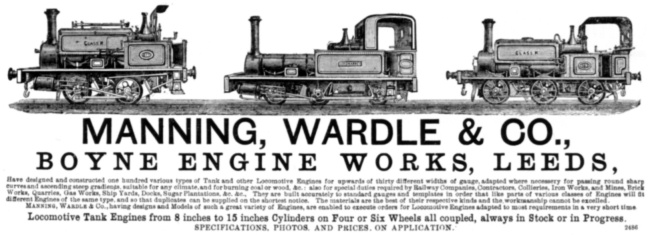
| THE INDUSTRIAL RAILWAY RECORD |
© JUNE 1974 |
MANNING WARDLE & CO.

Most Manning Wardle locomotives were built to standard class designs. The class letters seem to have been revised about 1870 and latterly comprised A to I, old Class I, and K to Q. Two of the classes (both standard gauge) are shown in this advertisement from the issue of "Engineering" dated 16th July 1880 (for which the copy was kindly provided by Ralph Martin).
Class H 677 was ordered on 26th July, steam tested on 29th July and despatched on 22nd August 1878 to John Riley & Sons, Hapton, Lancs. The reason for the speedy delivery is that construction for stock purposes was commenced earlier in the year, possibly at the same time 676 was ordered (February 1878) as both were built to the same order number (12600). The leading dimensions were: 12in x 18in cylinders, 3ft 0in wheels on a 5ft 4in wheelbase. 677 was the first of class H to have an injector manufactured by Manning Wardle. Sandboxes with rounded corners were introduced on class H from 676, although this feature is not particularly apparent in the drawing. According to Society records 677 was scrapped by Riley's at an unknown date.
The name of the second locomotive in the advertisement (Manning Wardle 536) reads NORDMARREN, but this conflicts with the Engine Book which shows it as NORDMARKEN. It was not a class engine, having 11in x 16in cylinders and 2ft 7½in wheels, and was built to 2ft 11/8in gauge (metric equivalent 891mm) for a Swedish customer to the order of John N. Sumner & Co. The weights on the leading, centre and trailing axle were: 5tons 6cwts 1qr 0lbs, 5‑10‑0‑14 and 4‑15‑0‑0 (empty) and 5‑17‑0‑0, 6‑2‑2‑0 and 6‑17‑0‑0 (full). No record was made of the date ordered, but 536 was steamed on 5th April 1875 and despatched fifteen days later together with Manning Wardle 532 FILIPSTAD. According to David Cole in Volume 1 of "Swedish Private Railways" (privately published in 1957) these two locomotives formed the total stock of the Filipstad Norra Berglas Railway in Värmland "county" where they were numbered 1 and 2 respectively. This small railway (17km in length) was taken over in 1890 by the Nordmark-Klarälvens Railway, and both 1 and 2 were subsequently altered to 2‑4‑0 tanks. Renumbered 9 and 10, they were scrapped in 1915 and 1919 respectively.
Class K 563 has a little more history. It was steamed on 22nd December 1875 and despatched on 25th January 1876 to Benton & Woodiwiss for use on a contract at Melton Mowbray. Extra block buffers for earth wagons were fitted, but these cannot be seen in the drawing. 563 had 12in x 17in cylinders and 3ft 1 3/8in wheels, and received a special canopy in November 1881. This was replaced by a diamond one in 1895 at the same time as new 12¼in diameter cylinders were fitted. It was originally No.17 but at some future date carried the name OLIVER, subsequent owners according to the Engine Book being G. & R. Thomas Ltd of Bloxwich and Holly Bank Colliery Co Ltd, near Wolverhampton (both Staffs). Society records indicate that Thomas acquired 563 about 1900 from a dealer named B.P. Blockley, and that it passed at an unknown date to the Holly Bank Coal Co Ltd where it was named NELLIE. The date of its demise is not known. (KPP)